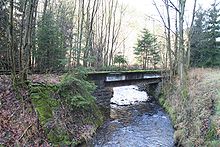Pressig-Rothenkirchen – Tettau railway line
| Pressig-Rothenkirchen-Tettau | |||||||||||||||||||||||||||||||||||||||||||||||||
|---|---|---|---|---|---|---|---|---|---|---|---|---|---|---|---|---|---|---|---|---|---|---|---|---|---|---|---|---|---|---|---|---|---|---|---|---|---|---|---|---|---|---|---|---|---|---|---|---|---|
| Route number : | 5014 | ||||||||||||||||||||||||||||||||||||||||||||||||
| Course book section (DB) : | 414y (1944) | ||||||||||||||||||||||||||||||||||||||||||||||||
| Route length: | 16.85 km | ||||||||||||||||||||||||||||||||||||||||||||||||
| Gauge : | 1435 mm ( standard gauge ) | ||||||||||||||||||||||||||||||||||||||||||||||||
| Maximum slope : | 23 ‰ | ||||||||||||||||||||||||||||||||||||||||||||||||
| Minimum radius : | 200 m | ||||||||||||||||||||||||||||||||||||||||||||||||
|
|||||||||||||||||||||||||||||||||||||||||||||||||
The Pressig-Rothenkirchen – Tettau line was a branch line in Bavaria . It branched off from the Hochstadt-Marktzeuln – Probstzella railway in Pressig-Rothenkirchen and led to Tettau in the Franconian Forest . The line crossed a short stretch of Thuringian territory, which in 1952 led to the cessation of operations as a result of the establishment of the inner-German border . The supply of the industry in Tettau and Alexanderhütte was maintained with road scooters for economic and political reasons . The line was formally closed in 1993.
history
After the completion of the Frankenwaldbahn in 1885, the first request for the construction of a branch line to Tettau was sent to the government in Munich in 1890. In particular, the glass and porcelain industry based in the so-called “Tettauer Winkel” was interested in a rail connection. In 1898, the General Directorate of the Transport Authority in Munich advocated a route along the Tettau River. For this, however, a state treaty between the Kingdom of Bavaria and the Duchy of Saxony-Meiningen was necessary, as the route was 8.1 kilometers in the area of Saxony-Meiningen, where it crossed the state border fourteen times. On March 10, 1900, the Bavarian State Parliament granted approval for the planning and construction of the local railway, and on July 9, 1901, the State Treaty between the two states was concluded. Most of the financing (1.2 million marks), the construction and operation of the branch line was done by Bavaria. Construction began in March 1902 and the line was inaugurated on June 23, 1903.
Up until 1939, three pairs of passenger trains ran daily, after which there were four. In terms of freight transport, the line developed as an important link for local industry for the supply of raw materials (around 15 to 20 wagon loads daily) and the transport of finished goods (around 10 to 12 wagon loads daily).
In the spring of 1945, the train traffic was interrupted as a result of a Tettau bridge being blown up. Since after the occupation of Thuringia by Soviet troops on July 3, 1945, the inner-German border, corresponding to the old state borders, crossed the route several times, the train connections were suspended. This led to a severe hindrance to production in the industrial plants in the Tettauer Winkel. It was not until October 16, 1946, after the Tettau Bridge had been repaired, that freight traffic could be resumed. There were three freight trains running weekly. From April 14, 1947, passenger transit was possible with two pairs of trains every weekday. The passengers in the so-called corridor trains had to keep the doors and windows closed while driving through the SBZ . In Heinersdorf Soviet soldiers led by passenger controls.
In the spring of 1952, the German Federal Railroad laid new sleepers and tracks on the line, and on May 28, 1952, train traffic ended after the line was closed by the GDR. In October the tracks in the GDR area were dismantled.
To supply the industry in the Tettauer Winkel with 2,500 employees, the Deutsche Bundesbahn started a road scooter traffic on June 1, 1952 . The freight wagons were delivered on the road from Steinbach am Wald to Alexanderhütte , which was newly built in 1951 . There the wagons were put on the rails and pushed with a small locomotive into the sidings to Tettau and Alexanderhütte. Up to 1989, around 3400 trips were made annually. The island operation between Tettau and Alexanderhütte was discontinued at the end of 1983, the small locomotive shunted wagons in Alexanderhütte until the end of 1992. In 1987, a private forwarding company took over the road scooter operation, which ended on May 31, 1996. The Free State of Bavaria promoted rail operations until 1992 by reimbursing additional freight costs.
After the temporary shutdown of the Pressig-Rothenkirchen-Tettau railway line, it was officially closed on December 13, 1993.
literature
- Ulrich Rockelmann, Thomas Naumann: The Frankenwaldbahn. The story of the steep ramp over the Franconian Forest . EK-Verlag, Freiburg 1997, ISBN 3-88255-581-5
- Wolfgang Beyer: Railway in the Sonneberger Land . Eisenbahn-Fachbuch-Verlag, Neustadt / Coburg 2004, ISBN 3-9807748-5-6

